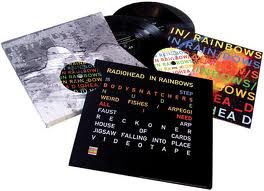From Disc to Digital: A Case Study on Radiohead's "Name Your Own Price" Method

A Study on Music Industry Business Practices in the 21st Century, and Radiohead's Self-Release Methodology
Over the past decade, the music industry has experienced extreme change due to digitization. Not only has it affected the way that music is recorded and produced, but it has also affected the entire business model of how music is promoted and distributed to the public, as well as how revenue is earned. Prior to the digital era, major labels were one of the primary distributors of music, and physical record sales were the one of industry’s main revenue sources. But when recordings were transformed to electronic format and free music sources such as illegal downloading and streaming evolved, this main revenue source was taken away. However, music digitization also opened many doors for artists, allowing them the tools and capabilities to promote and distribute their own work, as well as exposing their music to a wider audience.
Digitization began to cause problems for major labels for two reasons – the first being that free music services such as peer-to-peer file sharing and music streaming caused a large decline in album sales. This revenue loss caused music industry professionals to seek revenue elsewhere, such as in concert sales. The second problem digitization caused for record labels was that artists no longer relied on labels for their music promotion and distribution, as they now had these tools at their own disposal. In the old business model, before the Internet and music digitization evolved, the primary way for music distribution was through a record label. But in today’s world, artists are beginning to steer away from signing with major labels, as they now have access to their own marketing and distribution tools, and they don’t want to give away a large portion of their income.
According to Andrew Keen, “The irony of the digital commodification of content is that, while it destroys the value of the copy, it is actually adding to the value of physical events. Take, for example, the music industry. While it’s true that CD sales have been dramatically declining for years, the music business is actually experiencing a boom in live concerts. While consumers won’t pay for copies of the work of their favorite bands, they will pay for the privilege of seeing them live.” Keen also argues that “in the old industrial economy, artists played concerts to sell recordings; in the digital economy, artists gives away recordings in order to sell concert tickets,” which is why artists such as Radiohead and Nine Inch Nails are now separating from major labels and giving away their albums online as a means of promoting tickets for live events (Keen, 2009).
While conducting research on this subject, I used Radiohead as a case study, and analyzed the history of their album sales, concert sales, and how their music is produced, distributed and consumed in the digital era.I also analyzed the turnout of their "name your own price" self-release of In Rainbows.
Radiohead’s debut album Pablo Honey was released in 1993, and was followed by the release of The Bends in 1995, both of which have sold over 1.3 million copies to date (Elberse, 2008). But their peak album sales was in 1997, when their third album Ok Computer was released, which has sold over 4.5 million copies worldwide (Sexton, 2000).
In 2007, after Radiohead’s contract with EMI Records had expired, the band decided to self-release their new album In Rainbows as a digital download from their website, and allow users to select their own price for the album. The worldwide results showed that an average of 60% of users downloaded the album for free, while the other 40% paid for the album. The average price per paid download was $6.00 worldwide, and in the U.S. was $8.05 (Cabral, 2009).
In its first week, In Rainbows sold 122,000 copies, which was a significant drop from the band’s 2003 album Hail to the Thief, which sold 300,000 copies in its first week (Kafka, 2008). To date, it is estimated that In Rainbows has sold approximately 3 million copies, also a significant drop from their Ok Computer sales of over 4.5 million (Randall, 2011). However, even though the consumption of Radiohead’s music had changed, shifting from paid physical album sales to name-your-own-price digital downloads, production and distribution also played an important role in their changing business model.
Michael Laskow, CEO of the world’s leading independent A&R company, TAXI, states that “While the band, its fans and artists alike are celebrating what looks like a success for Radiohead's bold move in releasing their new album using the ‘pay what you'd like’ model, I think everybody has overlooked one very important aspect of this, and it doesn't bode well for the future of the music industry: Radiohead has been bankrolled by their former label for the last 15 years. They've built a fan base in the millions with their label, and now they're able to cash in on that fan base with none of the income or profit going to the label this time around. That's great for the band and for fans who paid less than they would under the old school model” (Cabral, 2009). So essentially, even though Radiohead may be selling less albums than in previous years, they’re also able to keep a much larger percent of the profits by producing and distributing the album themselves.
Radiohead’s front man Thom Yorke agrees with this statement, saying that “In terms of digital income, we've made more money out of this record (In Rainbows) than out of all the other Radiohead albums put together, forever — in terms of anything on the Net. And that's nuts. It's partly due to the fact that EMI wasn't giving us any money for digital sales. All the contracts signed in a certain era have none of that stuff” (Byrne, 2007).
In terms of their contract expiration with EMI, Yorke also states that “I like the people at our record company, but the time is at hand when you have to ask why anyone needs one. And, yes, it probably would give us some perverse pleasure to say 'F___ you' to this decaying business model" (Tyrangiel, 2007). But Yorke also believes that this method only works for them because of where they are, and the large fanbase they’ve built. For emerging artists, Yorke suggests, “Don't sign a huge record contract that strips you of all your digital rights, so that when you do sell something on iTunes you get absolutely zero. That would be the first priority” (Wired, 2007).
Even under the most lucrative record deals, artists can end up with less than 30% of overall sales revenue, which is then often split among several band members. But according to Time Magazine, even though record sales are declining, the concert business is booming (Time, 2007). Yorke also agrees with this, stating that “At the moment, we make money principally from touring” (Wired, 2007).
Luis Cabral argues that the most significant trend in the past decade is the “decrease in recording revenue and the increase in other income sources, especially touring.” According to Billboard’s editor Rob Levine, “Touring is the cash driver in the music business as album sales decline” (Cabral, 2009). For Radiohead, this also proves to be true. According to Billboard’s Boxscore, in September of 2003, Radiohead’s gross ticket sales were between $459,739 – 600,769 per show (Billboard, 2003). In November of 2003, Boxscore results were similar, totaling a gross of $598,944 per show (Billboard, 2003). However, in August of 2008, less than a year after their In Rainbows release, the band’s gross total had increased to $1,652,061 (Billboard, 2008). They also made Pollstar’s list of “Top 100 North American Tours” in 2008, grossing an average of 933,709 per show (Pollstar, 2008). But one of the highest figures was in May 2009, where their Billboard Boxscore gross totaled $5,175,752 (Billboard, 2009). Therefore, even though Radiohead’s album sales may have declined over the past decade, their concert sales have greatly increased.
Clearly, self-releasing In Rainbows was a smart business move on Radiohead’s part. Because of the small profit percentage with major labels, it makes more sense for artists today to either go with an indie label or self-release an album in order to actually turn a profit. So essentially, even though artists like Radiohead may have had a decline in album sales in recent years, they’re also keeping about ninety percent of the profits from In Rainbows because it’s self-released.
Radiohead has changed their business model by embracing the digital era and all the tools it has to offer. In the old business model, the band’s albums were produced and distributed via their label EMI, and music was primarily consumed by purchasing a physical album at a set price. In the digital era, Radiohead has now changed their music production, distribution and consumption by parting ways with their major label and self-releasing their album via digital downloading at a name-your-own price, which has resulted in a higher profit percentage for the band.
In addition, Radiohead has also been a prime example of how the music industry’s business model today primarily profits from concert sales. This case study shows that Radiohead’s album sales decreased from 4.5 million in 1997 to 3 million in 2007, however their concert sales increased from as low as $459,739 per show in 2003 to over 5 million per show in 2009. This is a clear example of how the primary revenue source for the music industry today has shifted from concert sales to album sales, and although album sales may be on the decline, concert sales are still increasing.
Sources:
"2008 Year End Top 100 North American Tours." Pollstar. N.p., 2009. Web. 3 Dec. 2011.
"Billboard Boxscore." Billboard 27 Sept. 2003: 23. Web. 4 Dec. 2011.
"Billboard Boxscore." Billboard 1 Nov. 2003: 30. Web. 4 Dec. 2011.
"Billboard Boxscore." Billboard 23 Aug. 2008: 15. Web. 4 Dec. 2011.
"Billboard Boxscore." Billboard 30 May 2009: 12. Web. 4 Dec. 2011.
Byrne, David. “David Byrne and Thom Yorke on the Real Value of Music.” Wired. 18 Dec. 2007.
Cabral, Luis. "The Economics of Rock Stars." . N.p., Oct. 2009. Web. 3 Dec. 2011.
Elberse, Anita, and Jason Bergsman. "Radiohead: Music at your Own Price." Harvard Business School 1 May (2008): 1-7. Web. 1 Dec. 2011.
Kafka, Peter. “Radiohead Selling Real Copies of In Rainbows for Real Money.” Business Insider. 9 Jan. 2008. Web. 29 Nov. 2011.
Keen, Andrew. "Why are Artists Poor? Self-Promotion and Making Money in the New Digital Economy” The Telegraph. 29 Aug. 2009. Web. 3 Oct. 2011.
Randall, Mac. Exit Music: The Radiohead Story. London: Omnibus Press, 2011. 98. Print.
Sexton, Paul. "Radiohead Won’t Play by Rules.” Billboard 16 Sep. 2000: 5. Web. 3 Dec. 2011.









